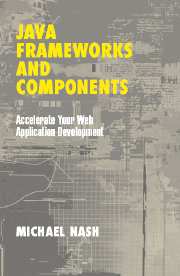Book contents
- Frontmatter
- Contents
- Acknowledgments
- 1 Components and Application Frameworks
- 2 Components: The Future of Web-Application Development
- 3 Application Frameworks: What Do They Provide and What Are the Benefits?
- 4 Choosing an Application Framework
- 5 A Catalog of Application Frameworks
- 6 Comparing Frameworks
- 7 Open Source and Components/Frameworks
- 8 Development Methodologies and Design Patterns
- 9 Integrated Development Environments
- 10 Strategies for Using Frameworks: Best Practices
- 11 Conclusions: The Future of Frameworks and Components
- Appendix: Case Studies
- Glossary
- Index
Appendix: Case Studies
Published online by Cambridge University Press: 28 July 2009
- Frontmatter
- Contents
- Acknowledgments
- 1 Components and Application Frameworks
- 2 Components: The Future of Web-Application Development
- 3 Application Frameworks: What Do They Provide and What Are the Benefits?
- 4 Choosing an Application Framework
- 5 A Catalog of Application Frameworks
- 6 Comparing Frameworks
- 7 Open Source and Components/Frameworks
- 8 Development Methodologies and Design Patterns
- 9 Integrated Development Environments
- 10 Strategies for Using Frameworks: Best Practices
- 11 Conclusions: The Future of Frameworks and Components
- Appendix: Case Studies
- Glossary
- Index
Summary
INTRODUCTION
The best way to get a “feel” for different frameworks when choosing between them is to use them – to put them to work thereby creating an actual application. In actual practice, this is seldom done. No one has enough time to spend creating throw-away applications in several different frameworks. Once a developer begins to use a particular framework, and dedicates time to learn it well enough to do the example, it is easy to continue, and to take advantage of what has been learned so far. To switch tracks and use another framework is difficult, and things that have been learned about the first framework must often be unlearned to properly use another.
The comparison is still very helpful; however, seldom it is done. Creating a similar application in multiple frameworks, even a very simple one such as the one used here, allows a point-for-point comparison between frameworks. If one of the frameworks you are giving serious consideration to is not one of the ones we have chosen for a case study, you might find it helpful to implement the same sample application as a starting point.
In this Appendix, we use several detailed code examples, so that you can see what developing the same application with different frameworks is like. We do not, for lack of space, list every source code line here. You can download a zip file of the complete source code from http://www.cup.org/titles/catalogue.asp?isbn=0521520592.
Information
- Type
- Chapter
- Information
- Java Frameworks and ComponentsAccelerate Your Web Application Development, pp. 377 - 456Publisher: Cambridge University PressPrint publication year: 2003
